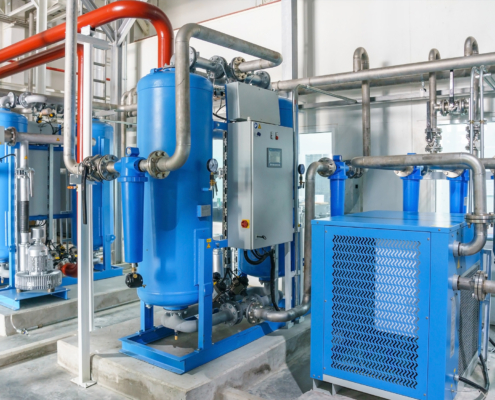 https://pioneerair.com/wp-content/uploads/2024/05/Choosing-Replacement-Desiccant-Air-Dryers-Pitfalls-to-Avoid.jpg
1250
2000
Abstrakt Marketing
/wp-content/uploads/2022/05/pioneer_air_systems_logo.png
Abstrakt Marketing2024-05-09 20:47:392025-11-28 20:29:13Choosing Replacement Desiccant Air Dryers: Pitfalls to Avoid
https://pioneerair.com/wp-content/uploads/2024/05/Choosing-Replacement-Desiccant-Air-Dryers-Pitfalls-to-Avoid.jpg
1250
2000
Abstrakt Marketing
/wp-content/uploads/2022/05/pioneer_air_systems_logo.png
Abstrakt Marketing2024-05-09 20:47:392025-11-28 20:29:13Choosing Replacement Desiccant Air Dryers: Pitfalls to AvoidWhat Is a Compressed Air System? The Complete Guide
What makes a compressed air system essential in various industries? What are its key components, and how do you enhance their efficiency while reducing energy consumption? What maintenance practices need to be implemented to prolong their service life? In this comprehensive guide, we’ll explore the basic principles of advanced applications, providing crucial insights to help users navigate and optimize their use of this indispensable machinery.
Overview of a Compressed Air System
Industrial applications often require reliable, safe, and efficient power sources. One such source is a compressed air system. Compressed air systems convert power into potential energy stored within compressed air, a concept extensively used in industrial and wide-ranging miscellaneous equipment applications. Both portable air compressors and industrial air compressors play a fundamental role in such systems.
The Role of Compressed Air in Various Industries
Compressed air is popularly known as the “fourth utility,” alongside water, gas, and electricity. Several industries rely on compressed air to power their pneumatic tools and machinery, such as air tools and railcar door openers. Important industries using compressed air include manufacturing, automotive, and food processing. Just imagine a day without compressed air, and you’ll realize how vital it is to the industrial sector.
Understanding Potential Energy in Compressed Air Systems
A critical factor in compressed air systems is the efficient storage and use of potential energy. When air is compressed, the applied pressure creates potential energy that can be stored and used later. This energy powers various industrial mechanisms, from basic air tools like impact wrenches to complex machinery like hydraulic rotary screw compressors.
The Essential Components of a Compressed Air System
Pressure Vessels: Air Receivers in Focus
Air receiver tanks, commonly known as pressure vessels, function as temporary storage spaces for the compressed air. These receiver tanks help maintain a stable pressure, cool the air, and trap impurities that may damage the compressor system or air tools. For many industries, selecting the right air receiver tank is crucial to setting up their compressed air system.
Types of Compressors
Several types of air compressors are used in various industries, each with unique advantages. The choice between a rotary screw compressor, a reciprocating compressor, or a centrifugal compressor depends largely on the application’s specific demands. For instance, rotary screw models are well-suited to continuous operation, providing a higher capacity compared to other types.
The Piping System and Its Importance in Delivering Compressed Air
The air compressor piping layout plays a vital role in a successful compressed air system. Good piping will reduce pressure drop, making the system more efficient and minimizing operating costs. Black iron pipe, for instance, is a commonly used material in compressed air piping. It’s advised to refer to the installation guide or owner’s manual of your compressor system for the optimal piping configuration.
If you are interested in learning more about breathing compressed air systems, be sure to check out this article highlighting their benefits.
Maintenance, Efficiency, and Troubleshooting of a Compressed Air System
Working with compressed air systems requires a dedicated focus on maintenance, efficiency, and troubleshooting. Ensuring these three areas are addressed can prolong your air compressors’ life, save energy costs, and prevent downtime due to unscheduled repairs. Compressed air is a vital resource in various industrial applications like railcar door openers, engine-driven, and hydraulic-driven tools; hence, it necessitates routine maintenance to function optimally. Rotary screws, portable air compressors, and miscellaneous equipment are widely used tools in these applications.
Crucial Practices for a Compressed Air System
Maintenance of compressed air systems includes an array of practices, from regular checks on air receiver tanks to more technical processes like positive displacement analysis on rotary screw compressors. Caring for air compressors is not limited to the duty electric motor or the hydraulic rotary screw. Other essential components like miscellaneous equipment, air treatment gears, and air compressor piping need periodical checks. Regular inspection of the black iron pipe used in the compressed air piping serves to reduce leaks and pressure drops.
Despite the varying types of air compressors, including open frame, enclosed hydraulic, engine-driven, and electric reciprocating models, they all share the commonality of needing clean, dry, and cool incoming air to function properly. This results in higher efficiency, increased equipment lifespan, and minimizes the risks of oil contamination.
Ways to Enhance System Efficiency and Achieve Energy Savings
Efficient use of compressed air doesn’t occur by accident. It’s a result of implementing deliberate strategies to maximize the performance of your compressor system and minimize resource wastage. For example, using a cube air system or ultra-compact system in smaller air tools can reduce energy costs and enhance efficiency.
Efficient operation also often extends to proper utilization of receiver tanks. Capacity boosting and system buffering can reduce compressor workload, optimizing the existing air storage. Regular air receiver tank maintenance and correcting pressure control issues will positively affect overall system efficiency.

Identifying and Resolving Common Issues
Even with a well-maintained compressed air system, occasional issues with your air compressors can arise. Pressure control problems, difficulties with condensate drains, and oil contamination are among the most common challenges industrial air compressor users face. Seek expert opinions for these intricate problems, as they would require a deep understanding of job site requirements and specific compressor model’s install guide or owner’s manual.
Search resource libraries like document and information libraries to find reference materials such as installation guides, owner manuals, and specific starter combos data sheets. These resources can assist you in maintaining your vacuum systems, rotary screw models, and free compressors effectively. Remember, well-guided troubleshooting can save you from costly repairs and ensure the sustainable operation of your compressed air system.
Future Trends in Compressed Air Systems and Technology
Compressed air systems have continually evolved, with potentially impactful future trends on the horizon. There’s much speculation around tomorrow’s technology, such as energy-free compressors, automated diagnostic systems, and high-efficiency portable air compressors. While these technologies might seem futuristic, they align with the industry’s push toward green technology and operability optimization.
Partner With Pioneer for the Best Compressed Air Systems Today
At Pioneer Air Systems, we take pride in offering the industry’s finest compressed air systems for industrial facilities. Our cutting-edge technology and expert engineering ensure top-notch performance, reliability, and efficiency, meeting your facility’s unique needs. Reach out to our expert team to get started today.
Related Postings
 https://pioneerair.com/wp-content/uploads/2024/05/Choosing-Replacement-Desiccant-Air-Dryers-Pitfalls-to-Avoid.jpg
1250
2000
Abstrakt Marketing
/wp-content/uploads/2022/05/pioneer_air_systems_logo.png
Abstrakt Marketing2024-05-09 20:47:392025-11-28 20:29:13Choosing Replacement Desiccant Air Dryers: Pitfalls to Avoid
https://pioneerair.com/wp-content/uploads/2024/05/Choosing-Replacement-Desiccant-Air-Dryers-Pitfalls-to-Avoid.jpg
1250
2000
Abstrakt Marketing
/wp-content/uploads/2022/05/pioneer_air_systems_logo.png
Abstrakt Marketing2024-05-09 20:47:392025-11-28 20:29:13Choosing Replacement Desiccant Air Dryers: Pitfalls to Avoid https://pioneerair.com/wp-content/uploads/2024/05/A-Guide-to-Desiccant-Types-Applications-and-Lifespans.jpg
1250
2000
Abstrakt Marketing
/wp-content/uploads/2022/05/pioneer_air_systems_logo.png
Abstrakt Marketing2024-05-09 20:39:292025-11-28 20:29:14A Guide to Desiccant Types, Applications, and Lifespans
https://pioneerair.com/wp-content/uploads/2024/05/A-Guide-to-Desiccant-Types-Applications-and-Lifespans.jpg
1250
2000
Abstrakt Marketing
/wp-content/uploads/2022/05/pioneer_air_systems_logo.png
Abstrakt Marketing2024-05-09 20:39:292025-11-28 20:29:14A Guide to Desiccant Types, Applications, and Lifespans https://pioneerair.com/wp-content/uploads/2024/03/Professional-inspecting-industrial-gas-system.jpg
1250
2000
Abstrakt Marketing
/wp-content/uploads/2022/05/pioneer_air_systems_logo.png
Abstrakt Marketing2024-03-04 14:44:192025-11-28 20:29:14Maintenance 101: Keeping Your Gas Hydrogen Dryer System in Peak Condition
https://pioneerair.com/wp-content/uploads/2024/03/Professional-inspecting-industrial-gas-system.jpg
1250
2000
Abstrakt Marketing
/wp-content/uploads/2022/05/pioneer_air_systems_logo.png
Abstrakt Marketing2024-03-04 14:44:192025-11-28 20:29:14Maintenance 101: Keeping Your Gas Hydrogen Dryer System in Peak Condition


